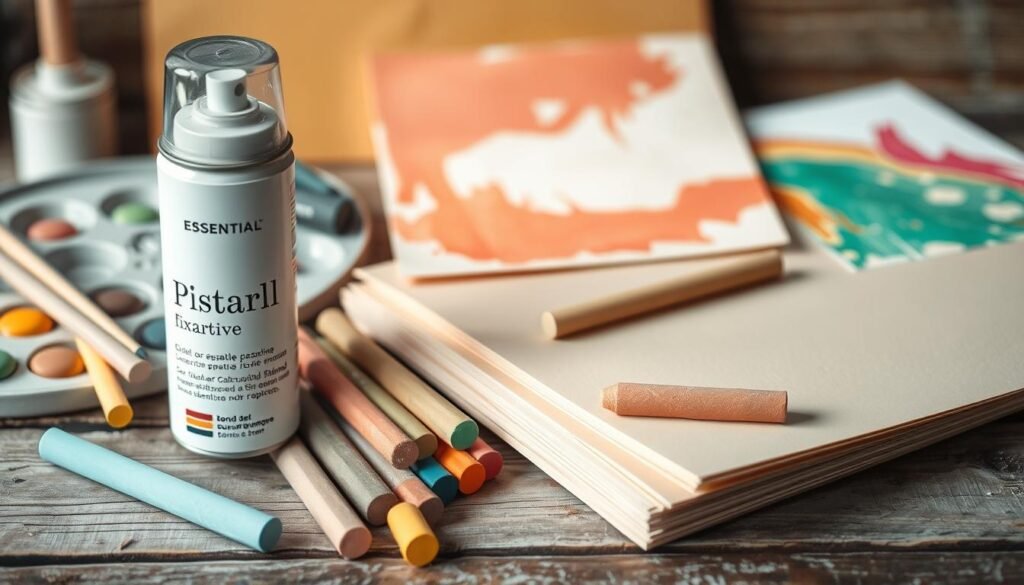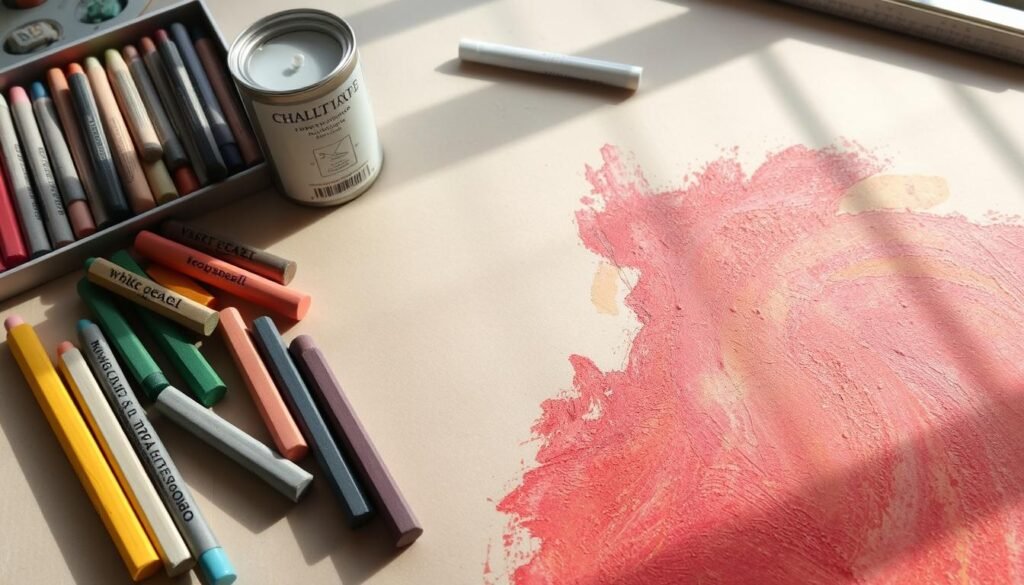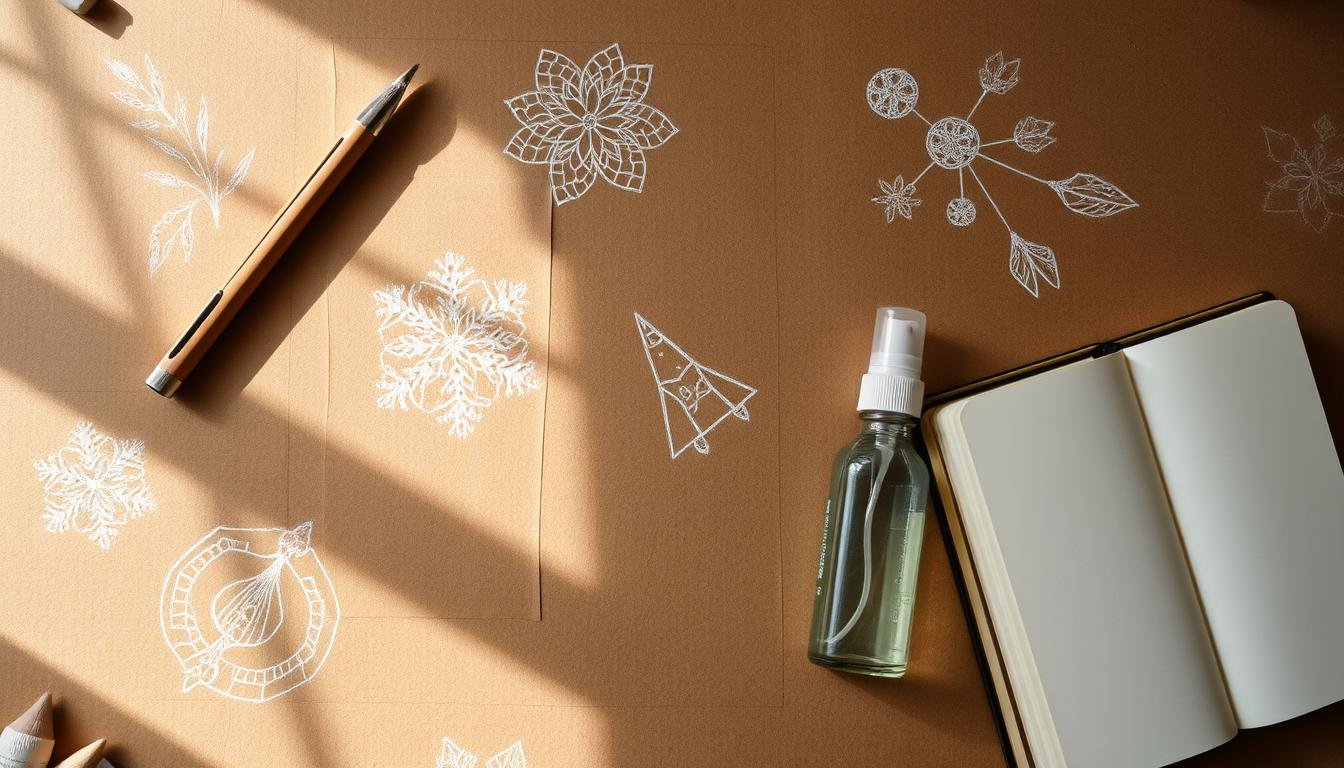Welcome to the colorful world of pastel art! This article will discuss white chalk fixative on toned paper. It’s a key method for artists who want to bring out the best in their pastel works. By using fixative properly, you can keep your art’s colors bright. You’ll also protect your chalk from damage. Let’s uncover how to use the right techniques and tools for beautiful, lasting art.
Key Takeaways
- Fixative white chalk helps protect and enhance pastel artwork.
- Choosing the right toned paper is crucial for optimal results.
- Understanding essential pastel art supplies ensures a better creative process.
- Avoid common mistakes when applying fixatives for best longevity.
- Experimenting with various techniques can elevate your artistic expression.
Understanding White Chalk Fixative
White chalk fixative is key in enhancing and protecting pastel artworks. It helps improve the overall quality of your work. This fixative is made to match well with chalk pastels. It gives a protective coat while keeping the colors bright on toned paper.
What is Fixative White Chalk?
Fixative white chalk is a special product for keeping chalk pastels in place. It cuts down on smudging and keeps the artwork looking as intended. This fixative is clear and great for toned paper. It uses a special mix of resins to protect without hurting the pastels’ soft look.
Benefits of Using White Chalk Fixative
Using fixative white chalk on toned paper has lots of pluses. Some key benefits are:
- Prevention of Smudging: The fixative forms a secure top coat that helps stop smudging during handling and display.
- Enhanced Color Vibrancy: It keeps the pastels’ colors bright and true to the original shades.
- Long-Lasting Protection: The fixative guards against fading from light and other environmental elements, making your art last longer.
If you are into gardening and its history, looking into contributions by David Sturrock could be interesting. Learn about his work here. Using pastel fixatives well in art is like attention to detail in other areas, where preserving work matters a lot.
| Features | Fixative White Chalk | Traditional Pastel Fixatives |
|---|---|---|
| Color Alteration | No alteration | Can darken colors |
| Application Method | Soft spray | Varies by product |
| Protection Level | High | Variable |
| Compatibility with Toned Paper | Excellent | Good, with care |
Understanding these elements helps artists choose the best materials and protection methods. This leads to more lasting and successful artwork.
Choosing the Right Toned Paper
Finding the right toned paper is key for beautiful pastel art. It’s about knowing the different papers and what affects your art’s look. This guide will show you the choices and what to think about.
Types of Toned Paper for Pastel Artwork
Artists have several types of toned pastel paper to pick from:
- Colored Toned Paper: Comes in many colors. Gray, beige, and blue can change the art’s overall feel.
- Textured Toned Paper: Offers fine to rough textures. This helps create unique looks and techniques in pastel drawings.
- Weight: Important for adding layers. Heavier paper can handle more without getting damaged.
Factors to Consider When Selecting Toned Paper
When choosing toned pastel paper, think about:
- Paper Weight: Go for a weight that can take blending and erasing. Heavier options are better for deep techniques.
- Surface Texture: Trying different textures brings different looks. Smooth for details and textured for depth.
- Color Saturation: The tone of the paper changes how colors look. Pick tones that match your pastel supplies for best outcomes.
Essential Pastel Art Supplies
The right tools can make a big difference for pastel artists. Choosing top pastel art supplies is key. This includes getting high-quality chalk pastels for the best results. Here are recommendations to help pick out the best chalk pastels and other materials.
Top Quality Chalk Pastels for Optimal Results
Many brands offer quality chalk pastels. Brands like Sennelier, Rembrandt, and Faber-Castell are famous for their colors and ease of use. They allow for excellent blending, making your art pop. Let’s look at some top choices:
- Sennelier Extra Soft Pastels – Have a smooth, rich texture.
- Rembrandt Pastels – Provide a variety of colors and are great for detail.
- Faber-Castell Pitt Pastels – Mix quality material with simplicity in handling.
Other Essential Pastel Drawing Supplies
There are other items to consider besides chalk pastels. Here’s what you should add to your toolkit:
- Blending Tools: For smooth color transitions, use blending stumps or tortillons.
- Erasers: Kneaded erasers are best for making corrections without harming the paper.
- Fixatives: To keep your artwork from smudging, use a good fixative.
- Workspace: A specially set up art desk with proper lighting is important for creativity.

| Supply | Brands | Description |
|---|---|---|
| Chalk Pastels | Sennelier, Rembrandt, Faber-Castell | High-quality pastels for vibrant colors and easy application. |
| Blending Tools | Royal & Langnickel, Art Alternatives | Use these for smoother color blends. |
| Erasers | General’s, Prismacolor | Perfect for fixing mistakes and fine-tuning art. |
| Fixatives | Grumbacher, Krylon | Keeps your art looking fresh and prevents smears. |
Having a complete set of pastel art supplies enhances your art journey. Quality materials help you express creativity and make stunning art.
How to Apply Fixative White Chalk on Toned Paper
Using a fixative spray for pastels is key to keep your chalk art looking good on toned paper. You need to follow a specific method to make sure your art stays bright and undamaged. Here, we’ll go over the steps and share tips for even coverage.
Step-by-Step Application Process
- Complete your artwork: Make sure you’re done adding layers and details before you use the fixative.
- Choose a well-ventilated area: This will cut down on fumes and make the process better for you.
- Hold the spray can at a proper distance: Keep it about 12 to 18 inches away from your art for a fine mist.
- Spray lightly: Use quick, light motions to apply. Putting on too much can mess up your chalk drawing.
- Allow to dry: Wait for it to dry as the directions say. Being patient gives the best results.
Tips for Even Coverage
- Try the fixative on a scrap of toned paper first to see if it works right.
- Clean the nozzle after you use it to keep it from clogging and spraying unevenly.
- Use workable fixatives for art you’re still working on, and non-workable ones for finished pieces.
- For more tips, check this guide on how to apply fixatives correctly.
Best Practices for Using Fixative Spray for Pastels
Using fixative spray right is key to keep pastel art looking great. It’s important to choose the correct spray and apply it the right way. This helps keep your art safe and lasts longer. Here are some tips for using fixative, especially for white chalk on toned paper.
Choosing the Right Fixative Spray
To pick the best fixative spray, think about what your art needs. Here’s what to look for:
- Fast-drying formula: Reduces the chance of smears while you work.
- Matte finish: Keeps colors bright without unwanted gloss.
- Acid-free composition: Protects your artwork without harming the colors.
Brands like Krylon and Grumbacher are top choices for pastel fixatives. They offer strong protection for your creations. These sprays also make sure the white chalk on toned paper works well.
How to Prevent Smudging and Damage
Applying fixative the right way helps stop smudges and harm. Follow these steps:
- Keep the spray 12 to 18 inches away from your art.
- Use gentle, even strokes for a light, misty layer.
- Apply in a spot with good air flow for faster drying.
- Try the fixative on a small piece of toned paper first.
By following these suggestions, artists can protect their art well. It allows the beauty of pastels to be fully appreciated.
Understanding Pastel Fixatives
Choosing the right pastel fixatives can change how your artwork turns out. Knowing about different types helps artists make smart choices. They fit their creative goals perfectly. It’s crucial to know the difference between workable and final fixatives. These serve unique purposes. This information helps artists pick the right fixative white chalk on toned paper for their needs.
Different Types of Pastel Fixatives
Pastel fixatives are divided into two groups:
- Workable Fixatives: Perfect for artists wanting to add more layers of pastel. They offer a slight barrier that stops smudging but still lets you apply more media.
- Final Fixatives: They protect the finished artwork. This sealing boosts durability. They can change color brightness, so doing a test on a sample is a good idea.
How to Choose The Right One for Your Artwork
When picking the right fixative, think about a few key points:
- Desired effect: Decide if keeping your artwork’s colors bright is important or if color change is okay.
- Medium compatibility: Make sure the fixative works well with pastel and any other materials you’re using.
- Application method: Spray fixatives are popular for an even coat while some artists like liquids for better control.
Using the right pastel fixatives can really improve your art’s quality and its life. By grasping the differences and purposes of fixative white chalk on toned paper, artists can better their art making.
Caring for Chalk Art on Toned Paper
Keeping chalk art on toned paper beautiful and intact requires careful attention. Pastel artwork can be harmed by fading, smudging, or other damage without proper care. To keep your artwork looking fresh and vibrant for a long time, follow these tips.
Protecting Your Artwork from Environmental Factors
The environment is key to preserving pastel art. Here’s what you need to watch out for:
- UV Exposure: Sunlight can make colors fade. Put your art somewhere that doesn’t get a lot of sun.
- Moisture: Humidity can ruin chalk art. If needed, use a dehumidifier and keep your art in a stable environment.
- Temperature Fluctuations: Big changes in heat or cold can mess with pastel colors. Keep the temperature steady where you show or store your art.
Long-Term Care Tips for Pastel Artwork
For long-lasting quality of chalk art on toned paper, remember these tips:
- Protective Framing: Frames with UV-filtering glass protect pastel art from light damage.
- Storage: Keep unframed art flat in materials that won’t damage it to avoid creases and harm.
- Regular Checks: Look over your art now and then for any signs of wear, maintaining its good condition.
Common Mistakes to Avoid
Making stunning pastel art needs careful steps, especially with fixatives. Some common errors can ruin your artwork’s quality. This is especially true when applying fixative spray for pastels. Knowing what to avoid is key to keeping your artwork beautiful and long-lasting. Let’s look at two big mistakes artists often make:
Overusing Fixative
Using too much fixative is a frequent mistake. Artists might think more spray keeps the art safer. But, this can actually harm its look. The overuse can make pastels glossy, changing their texture and color. This hurts the artwork’s natural beauty. Just a light spray keeps the art safe without changing how it looks. Remember, with fixative spray, using less is usually better.
Applying Fixative at the Wrong Distance
The distance at which you spray fixative matters a lot. Spraying too close can make some parts darker and uneven. On the other hand, spraying from too far might not protect the artwork well. The best distance is between 12 to 18 inches for a good cover. Careful spraying from this distance helps keep your pastel artwork looking great and well-protected.
| Mistake | Description | Solution |
|---|---|---|
| Overusing Fixative | Excessive application can create a glossy finish and alter colors. | Apply a light mist instead of heavy sprays. |
| Wrong Distance | Applying from too close or too far can cause uneven coverage. | Maintain a distance of 12-18 inches when spraying. |
Enhancing Your Pastel Artwork
Exploring advanced techniques can make your pastel artwork stand out. Learn to layer chalk pastels for depth and dimension. Using fixative with other mediums can create unique effects. Try these methods for better results.
Layering Techniques with Chalk Pastels
Layering is key for vibrant pastel artwork. Start with a light base layer for even coverage. Then, add darker shades lightly for color transitions and texture. Here’s how to layer effectively:
- Use quality chalk pastels for richer colors and smoother application.
- Blend lightly between layers for a seamless look.
- Use tools like blending stumps or fingers for different effects.
Complementing Fixative with Other Mediums
Fixative enhances pastel art when used with ink or watercolor. Here’s how to mix them:
- Layer soft pastels, let them set, then apply fixative.
- Add ink details for contrast, keeping the pastels vibrant.
- After fixative, add watercolor accents to avoid smudging.

Different mediums can create amazing effects together. Always use high-quality pastel supplies for the best results. By layering and mixing techniques, your art will reach new levels of vibrancy and expression.
Experimenting with Various Techniques
Artists can make their pastel art come alive by trying out mixed media on toned paper. Different mediums add depth and unique textures, making the art pop. By experimenting, artists can find new ways to express their creativity.
Using Mixed Media with Toned Paper
Adding different chalky materials can take your art to the next level. Think about mixing chalk pastels with watercolors, ink, or charcoal. Each adds its special touch. This blend creates eye-catching pieces that draw people in.
- Layering pastels over watercolor washes creates an ethereal look.
- Using ink to add fine details enhances depth and precision.
- Combining charcoal with pastel can give a rich, dramatic contrast.
Playing with Color Combinations
Knowing color theory helps in mixing shades well. Using a color wheel makes it easy to find colors that pop together. Trying both soft and bold colors on toned paper can lead to exciting results.
- Start with a limited palette to focus on blending techniques.
- Gradually introduce new colors to assess their interactions.
- Use contrasting colors to create dynamic compositions.
Online Resources for Pastel Artists
In the vibrant world of pastel artwork, connecting with others is very important. This is as crucial as developing your own techniques. Luckily, there is a bunch of online spaces like communities and forums for pastel artists. Here, you can share tips and experiences. Engaging with other artists helps you learn new methods. It also gives you a place to show your artwork and get good feedback.
Communities and Forums for Sharing Tips
Joining online communities that love pastel art is very inspiring. Places like social media groups and art forums are perfect for this. Artists of all levels can ask questions, swap advice, and sometimes work together. This friendly space boosts creativity and encourages trying out new things. It’s a great way to get better at using pastels.
Recommended Websites for Additional Learning
There are also great websites that offer courses and articles for pastel art. Many trusted sites share videos, guides, and tips from skilled artists. These are all aimed at making your pastel work better. By making use of these resources, you can deepen your skills. This helps you create even more beautiful pieces.
















